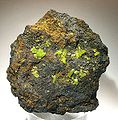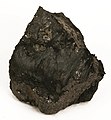Dognecea Mountains
| Dognecea Mountains | |
|---|---|
|
Location of the Banat Mountains with the Dognecea Mountains |
|
| Highest peak | Culmea Poețiilor ( 617 m ) |
| location | Romania |
| Part of the Banat Mountains | Western Romanian Carpathians |
| Coordinates | 46 ° 45 ′ N , 21 ° 55 ′ E |
| rock | limestone |
| particularities | Karst landscape |
The Dognecea Mountains ( Romanian Munții Dognecei ) is a mountain range in the Banat Mountains , the southern part of the Western Romanian Carpathians . The Dognecea Mountains are located in the Caraș-Severin County , in southwest Romania . The highest peak, Culmea Poețiilor, is 617 meters high.
Geographical location
The Dognecea Mountains are easily accessible, the main access points are the towns of Bocşa and Reşița , which can be reached from all parts of the country by road. Both towns can also be reached by train on the Timișoara -Bocșa-Reșița, Caransebeș -Reșița and Anina - Oravița - Berzovia -Bocșa-Reșița routes.
description
The Dognecea Mountains are bounded by the Pogăniș Corridor in the north, the Reșița Corridor in the east, the Caraș Valley in the south and the Dognecea Hills in the west . The two most important villages at the foot of the Dognecea Mountains are Reșița in the east and Bocșa in the north. The Dognecea Mountains are crossed in an east-west direction by the Bârzava , which divides the mountains into a northern and a southern area, the northern area with the highest peak Cula Arenișului with 549 meters and the southern with the summit Culmea Poețiilor , also Culmea Mare , called with 617 meters. The southern area is in turn divided by the Dognecea in a north-south direction into a western and an eastern area. In addition to the Bârzava, the Dognecea Mountains are crossed by the Dognecea , Moravița , Bocșișa , Ferendia and Tău rivers . Some of these rivers were dammed for industrial use. This is how the reservoirs "Vârtoape" and "Vârtop" on the Ferendia River, "Lacul Mare" and "Lacul Mic" on the Dognecea and "Dănilă" on the Moravița were created.
The karst landscape in the Dognecea Mountains has unique surface shapes, such as sinkholes , gorges or underground formations. The 17 caves include the Peştera Butoara Urieşilor , Peştera Casa Lotrilor and Avenul Dănilă II . The Dognecea Forest Nature Reserve and Valeapai fossil site are the only protected areas in the Dognecea Mountains. In the Dognecea forest reserve, which extends over an area of 315 hectares, oaks ( Quercus ) are under nature protection. The Valeapai fossil deposit is a paleontological reserve and extends over an area of 2 hectares in the area of the village of Valeapai . Protected are fossil remains of hollow animals ( coelenterates ), mussels ( Lamellibranchiata ), snails ( Gastropoda ), coral ( Korallion ) and mollusks ( Mollusca ).
The Dognecea Mountains are rich in ores . In 1720 the first copper smelting furnace on the territory of today's Romania was put into operation in Dognecea .
Flora and fauna
The Dognecea Mountains are covered with extensive forests. Mainly: English oak ( Quercus robur ), Turkey oak ( Quercus cerris ), Hungarian oak ( Quercus frainetto ), common beech ( Fagus sylvatica ), hornbeam ( Carpinus betulus ), common ash ( Fraxinus excelsior ), winter linden ( Tilia cordata ). Large areas are grazing land .
The fauna is represented by mammals : wolf ( Canis lupus ), squirrels ( Sciurus vulgaris ), pine marten ( Martes martes ), wild boar ( Sus scrofa ), roe deer ( Capreolus capreolus ), red fox ( Vulpes vulpes ). The ichthyofauna is represented by: carp ( Cyprinus carpio ), chub ( Leuciscus cephalus ), European catfish ( Silurus glanis ), crucian carp ( Carassius carassius ).
Individual evidence
- ↑ thegreatcarpathians.com ( Memento of the original from February 22, 2014 in the Internet Archive ) Info: The archive link was automatically inserted and not yet checked. Please check the original and archive link according to the instructions and then remove this notice. , Munții Dognecei ( Romanian )
- ↑ banatulmontan.wordpress.com , Munții Dognecei ( Romanian )






